Improved Mechanics For An Improved Taijuan Walker?
Trades are funny. I mean, there’s such a wide range of responses no matter the deal. Trade Ian Kennedy for Matt Stites? Great move, save money. Bad move, Ian Kennedy eats innings. Trade Adam Eaton and Tyler Skaggs for Mark Trumbo? Bad move, Eaton and Skaggs are budding young players. Great move, DINGERZ. Trade Dansby Swanson, Ender Inciarte and Aaron Blair for Shelby Miller? Good move, we need proven pitching. Bad move, obviously. Trade Jean Segura, Mitch Haniger, and Zac Curtis for Taijuan Walker and Ketel Marte? You get the idea, and while essentially every analyst you can find likes the deal for the Diamondbacks (and the Mariners), there are still some detractors. Thing is, the success of the trade hinges on a couple of small things that will make or break the deal for the D-backs.
When the trade broke, I assessed the value of the deal and came to the basic conclusion that the methodology was sound. Ryan took a look at Walker himself and found that his repertoire may prove particularly fruitful in Arizona. But what you’ve likely read all over this here internet is how Taijuan Walker is a young pitcher with big upside, but previously unrealized potential. Let’s just observe, for a moment, the very mediocre results to date for Mr. Walker:
There’s not a lot here that will blow you away. There are some decent ERA and FIP numbers at young ages in small samples, but they’re most home run-related (he limited the long ball). Similarly, there are some inflated ERAs and FIPs in larger samples that are, again, home run-related (too many homers yielded). The results here are far from inspiring, but again, you’ve heard plenty about Taijuan Walker’s upside. That’s due in large part to the pitches that Ryan described yesterday, but you’ve maybe heard about Walker’s turnaround last September, too. Let’s talk about that.
On September 3rd, Walker got crushed by the Angels. It was his worst start of the season, notching only two outs while surrendering six runs (five earned) and three homers. He didn’t make it out of the first inning and it was back to the drawing board for Walker, who worked with former D-backs-turned-Mariners pitching coach Mel Stottlemyer to make some adjustments. You can read more about that process from the ever-splendid Nick Piecoro here, but let’s take our own look and see what we can discern.
First, observe the two video clips below. The top clip is from May 29th against the Minnesota Twins. The second is from September 9th against the Texas Rangers. See if you notice any changes to Walker’s delivery.
On this quick glance, it appears that Walker was flying open too early in his delivery and the adjustments were made, in part, to help him stay closed longer. It might be easier to see in the still frames below.
From May:
From September:
Both images are at peak leg-lift from the young right-hander. In the top image from May, Walker’s shoulder’s are square with third base and lined up directly with the catcher. His hips are facing third as well, as you can use his belt buckle as an indicator of his alignment. In the bottom image from his second start in September, Walker shows more of a coil — his shoulders have rotated past third base and his hips have rotated further, as well, while the front leg is coming back over the rubber. Compare his head’s position in both images. In May, he’s facing the catcher at peak leg lift. In September, he’s somewhere up the third base line from home plate. There’s a saying in sports: where the head goes, the body will follow. Add up all of the changes and you can see that Walker is trying to stay back in his delivery, keeping his front shoulder tucked in and pointed to the right of home plate while coiling his lower half, too. This all keeps him from opening his front side too early, something that often leads to balls being left up in the zone.
And, if you recall, many of Walker’s ERA-related problems have been home run-driven. This mechanical changes seems to fly directly in the face of that troublesome trend. In his last five starts, Walker did cut his home run rate by about 35%, which is to say that while he gave up some bombs, he managed to give up fewer of them. During that same stretch, he notched a ground ball rate at or above 50% four times. In his other 20 starts last season, he did it just three times total, and all of those starts were in April. Walker appears to have been able to keep the ball down after his adjustments, as indicated by his zone profile.
Walker Zone Profile Pre-Adjustment
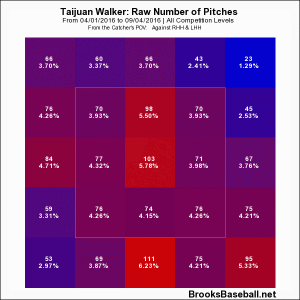
Walker Zone Profile Post-Adjustment
We’re not talking about a massive change here, but he avoided several of the balls at the top of the zone, the kind that often turn into homers. He also avoided the heart of the plate, the true danger zone. It’s a small sample but the results are encouraging. So, while on the surface you may think the D-backs traded for a struggling pitcher, they may have actually traded for one that’s just turned a corner. His mechanics will be something to focus on come spring, but given his most recent success, you’d fully expect them to carry over to 2017.
I know everyone hates projections, but here’s a fun fact: Steamer forecasts 2.2 fWAR for Jean Segura in 2017 and 2.2 fWAR for Taijuan Walker in 2017. Maybe Segura’s swing adjustments will lead him to continued success in Seattle, but maybe Walker’s mechanical adjustments will lead to continued success in Arizona. It’s easy to point at 2016 and say the D-backs gave up too much production, but that’s over-simplifying things. A change of scenery may be good for Walker just as it was for Segura, as Walker had fallen out of favor in Seattle to some degree. He gets to hit the reset button and bring his improved mechanics with him, though Chase Field won’t do him any favors. Still, there’s the raw stuff to succeed, some refined mechanics to help, and four more years of team control for the D-backs to enjoy. He’s a young pitcher and not a finished product, so there’s reason to remain hopeful. When you hear about upside, this is what the organization is talking about. The best Taijuan Walker is still out there and while he didn’t unveil it in Seattle, he may be about to do so in Arizona. For that, we should remain optimistic.
5 Responses to Improved Mechanics For An Improved Taijuan Walker?
Leave a Reply Cancel reply
Recent Posts
@ryanpmorrison
 Congrats to @OutfieldGrass24 on a beautiful life, wedding and wife. He deserves all of it (they both do). And I cou… https://t.co/JzJtQ7TgdJ, Jul 23
Congrats to @OutfieldGrass24 on a beautiful life, wedding and wife. He deserves all of it (they both do). And I cou… https://t.co/JzJtQ7TgdJ, Jul 23 Best part of Peralta’s 108 mph fliner over the fence, IMHO: that he got that much leverage despite scooping it out… https://t.co/ivBrl76adF, Apr 08
Best part of Peralta’s 108 mph fliner over the fence, IMHO: that he got that much leverage despite scooping it out… https://t.co/ivBrl76adF, Apr 08 RT @OutfieldGrass24: If you're bored of watching Patrick Corbin get dudes out, you can check out my latest for @TheAthleticAZ. https://t.co/k1DymgY7zO, Apr 04
RT @OutfieldGrass24: If you're bored of watching Patrick Corbin get dudes out, you can check out my latest for @TheAthleticAZ. https://t.co/k1DymgY7zO, Apr 04 Of course, they may have overtaken the league lead for outs on the bases just now, also...
But in 2017, Arizona ha… https://t.co/38MBrr2D4b, Apr 04
Of course, they may have overtaken the league lead for outs on the bases just now, also...
But in 2017, Arizona ha… https://t.co/38MBrr2D4b, Apr 04 Prior to the games today, there had only been 5 steals of 3rd this season (and no CS) in the National League. The… https://t.co/gVVL84vPQ5, Apr 04
Prior to the games today, there had only been 5 steals of 3rd this season (and no CS) in the National League. The… https://t.co/gVVL84vPQ5, Apr 04
Powered by: Web Designers@outfieldgrass24
 I’ll never forget seeing Kyle Seager at the Scottsdale Fashion Square one March with his family and thinking “damn,… https://t.co/uapNYdsU2a, 17 hours ago
I’ll never forget seeing Kyle Seager at the Scottsdale Fashion Square one March with his family and thinking “damn,… https://t.co/uapNYdsU2a, 17 hours ago Big dogs. Bigger trees. @ Avenue of the Giants, Nor Cal https://t.co/YAdxcE1t1p, Dec 29
Big dogs. Bigger trees. @ Avenue of the Giants, Nor Cal https://t.co/YAdxcE1t1p, Dec 29 Old friend alert https://t.co/7HQjiyBWTB, Dec 27
Old friend alert https://t.co/7HQjiyBWTB, Dec 27 Death wish https://t.co/XJzcMkNPTy, Dec 26
Death wish https://t.co/XJzcMkNPTy, Dec 26 Feeling cute might delete https://t.co/NyqGSXVOwQ, Dec 25
Feeling cute might delete https://t.co/NyqGSXVOwQ, Dec 25
Powered by: Web Designers

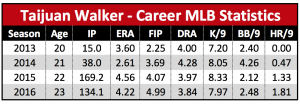

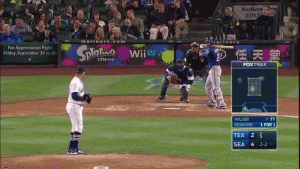
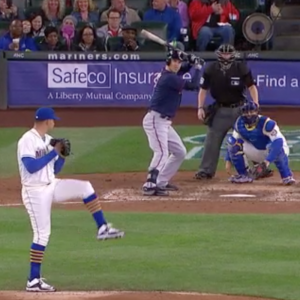
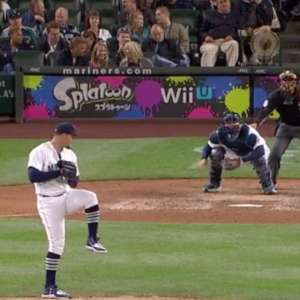
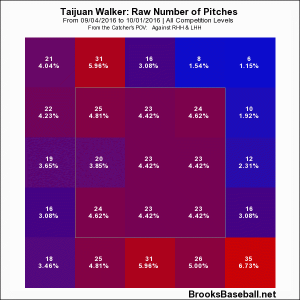




I AM NOT A STATISTICS GUY LIKE YOU AND MOST OF YOUR READERS, BUT WHAT I SEE IS A TRADE FOR ANOTHER YOUNG PITCHER WHO HAS NOT REALIZED HIS POTENTIAL TO GO WITH A STABLE OF YOUNG PITCHERS WITH POTENTIAL REALIZATION PROBLEMS ( NOT TO MENTION THE BREAK THE BANK PITCHER ) AND THE D-BACKS GAVE UP THEIR BEST PLAYER FROM LAST SEASON TO ADD MEDIOCRITY TO A MEDIOCRE PITCHING CADRE. ( AND A NO HIT/WEAK GLOVE INFIELDER.)
Also Segura is replaceable with Owings and Drury.
First to my fellow dbacks fan LEE KING as I’d like to ask that the all caps button on his Dell get fixed. I’ve got a nasty habit of reading out loud and my Austrian neighbors must think the American immigrant needs to go home… 2016 doesn’t like immigrants, please!
So, when I compare the article to the above comment, I see both sides. Why have an entire artillery unit made up of young and developing guys? So they can learn to hit the target while on your side. Play the odds and a few will be great. WALKER, um I mean Walker nearly adds to their chances of rotation success. This move honors the baseball gods in that we know many players try and fail while some will succeed. Who succeeds still remains somewhat in the hands of the gods.
Now about that business of the trade? Segura was something of a reverse bet. A bet that he’s not who we saw last year. I struggle with that idea and think his odds at continued success are very high. We could take this great article about WALKER, um WALker, for Pete’s sake… We could take this great article about Walker and expect something similar about Segura.
For his part, Walker is clearly making adjustments and finding success, credit Wiser. My main concern is if he is the guy that will continue to make adjustments. Its a carrier for the best in MLB. Not only to be willing to make adjustments but to choose and make adjustments that matter.
This link isn’t pitching but is the mentality I hope Segura had and Walker is running towards.
https://youtu.be/Yae1KxRSq0g
Oh, and this lyric never made more sense than it does now. A tad of German needed for the fun.
“Realize I don’t want to be a miser
Confide with sly you’ll be the wiser
Young blood is the lovin’ upriser
How come everybody want to keep it like the kaiser”
I loved Segura as a hitter, lead off hitter and base runner; however, I understand the trade. My prior criticism of the trade was the headline that we “sold high.” My point was that, as this post agrees, we traded for a guy with unrealized potential–otherwise known as a guy with a high, but unrealized, ceiling. Walker is not a sure thing for the reasons outlined. The club website (understandably) keeps stressing the upside and I agree that it is there; but I also see the HR propensity, the lack of a consistent second (much less third) pitch, the inability to pitch beyond the fifth inning and the inability to pitch out of a stretch. So I think this was a valid, legitimate trade–that we should not, however, oversell and not hype through headlines like “selling high.” Walker might not be as bad as Shelby Miller (who we continue to refer to as a potential star for reasons not clear to me), but he might not be as good as the (so far) overrated (but high ceiling) Robbie Ray. I see a bunch of potentially capable guys, including Walker, who are capable of, maybe, eight wins a season. So, again, I like the trade, but don’t over hype it as Walker may be just a new version of RDLR. Let’s be optimistic, but also realistic. Jeff, nice post.
Not having seen much of Walker, I have to say I’m a fan. He throws hard and has a very simple delivery. He’s effective against lefties too, if he can manage the homerun ball, I think he’ll have more success then Miller did last year.